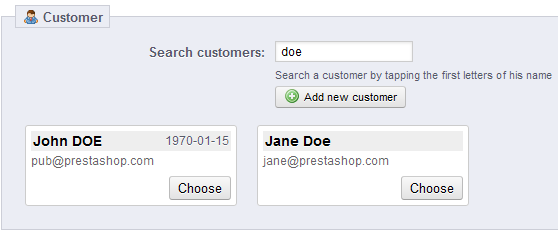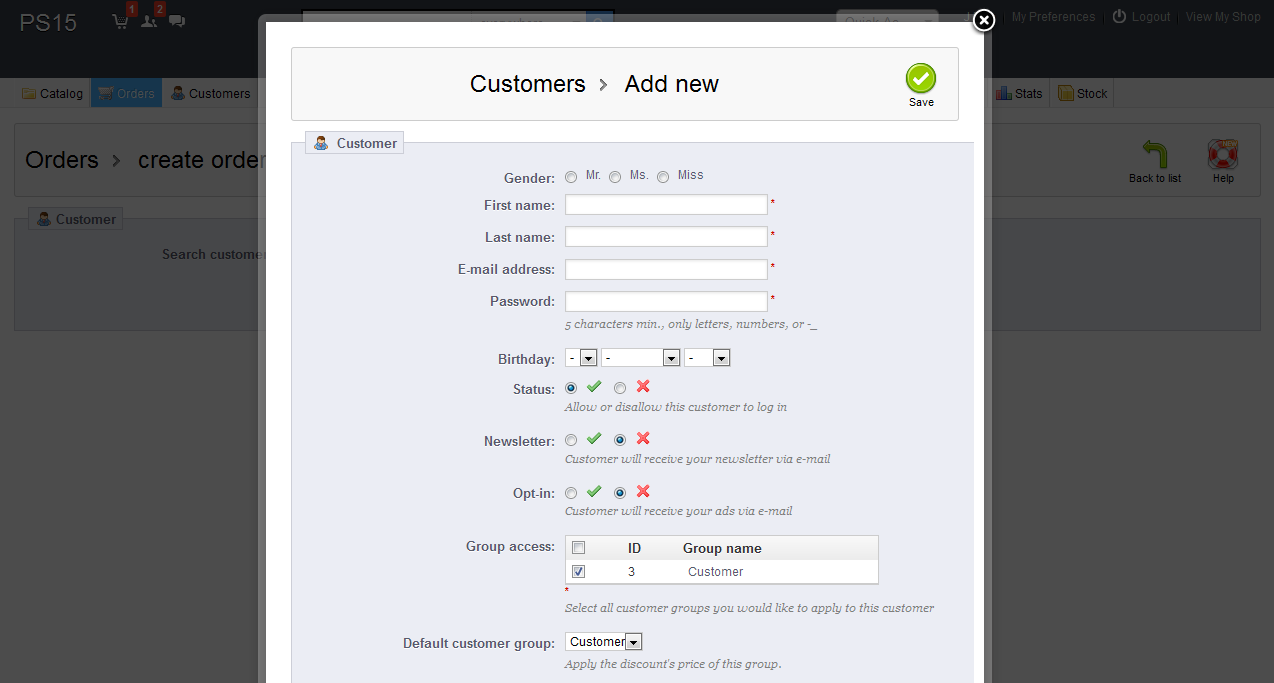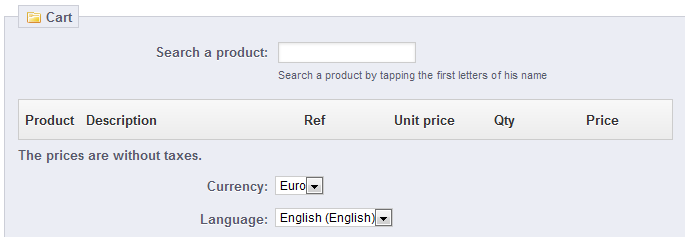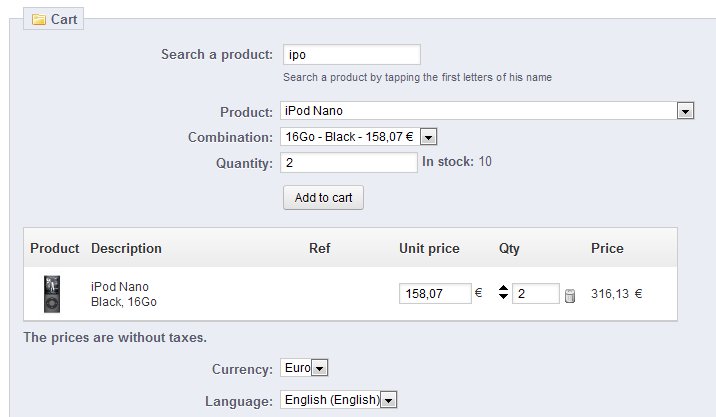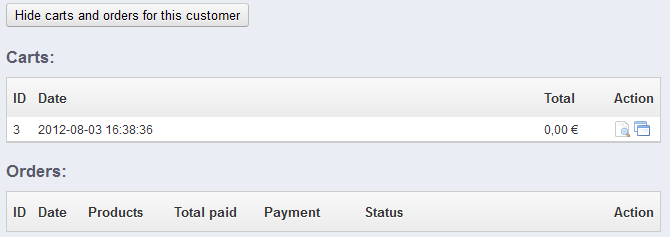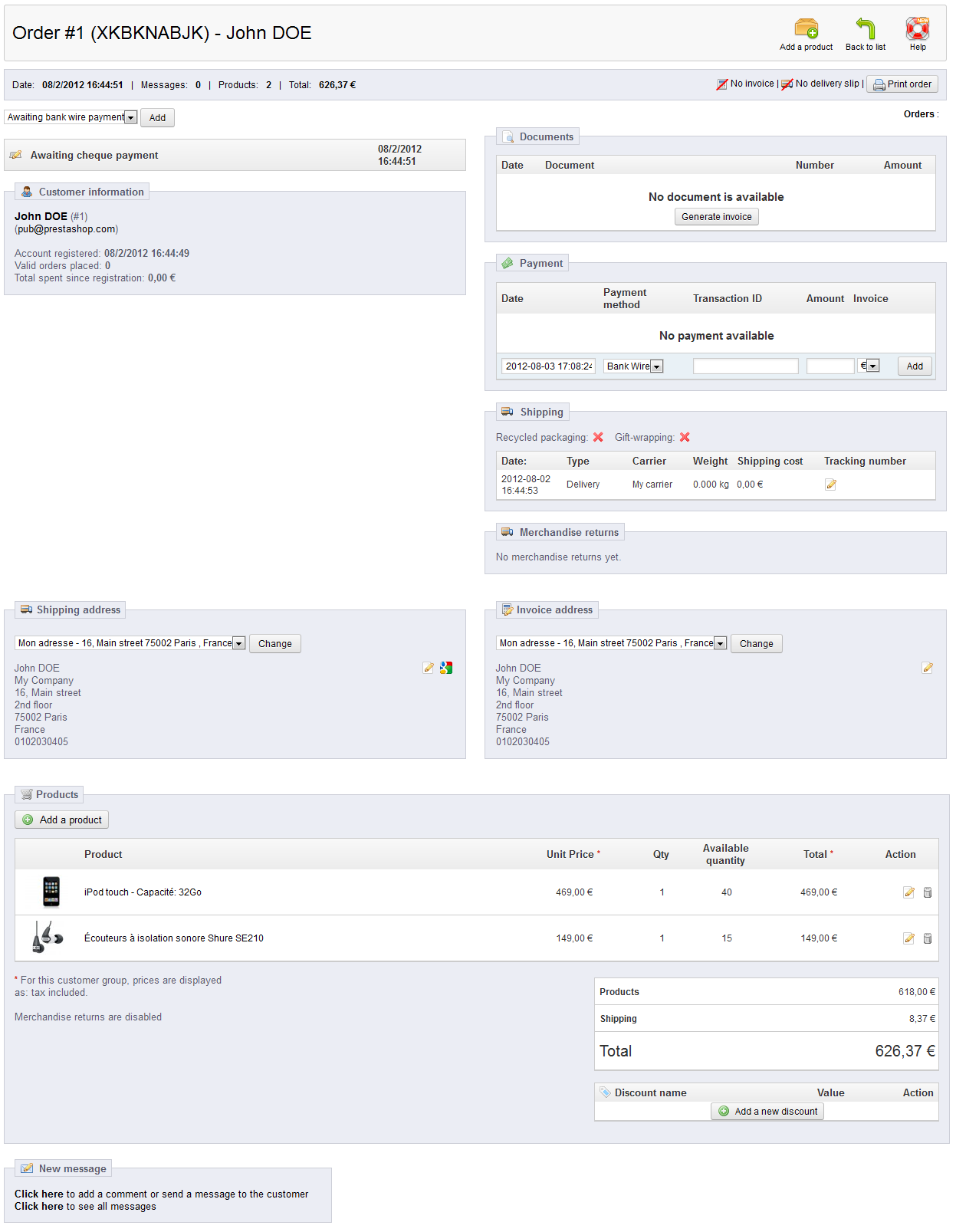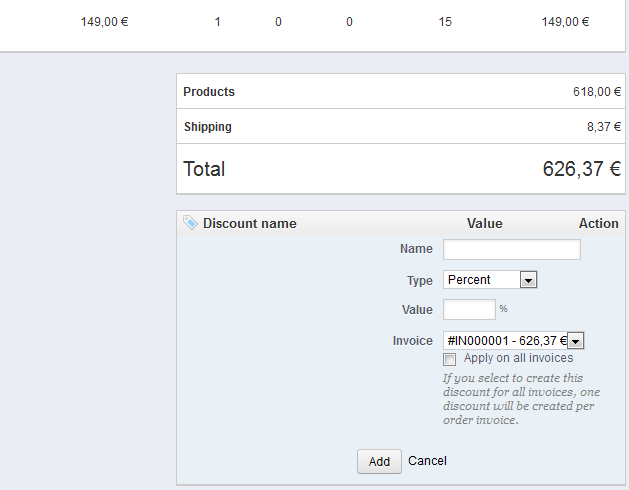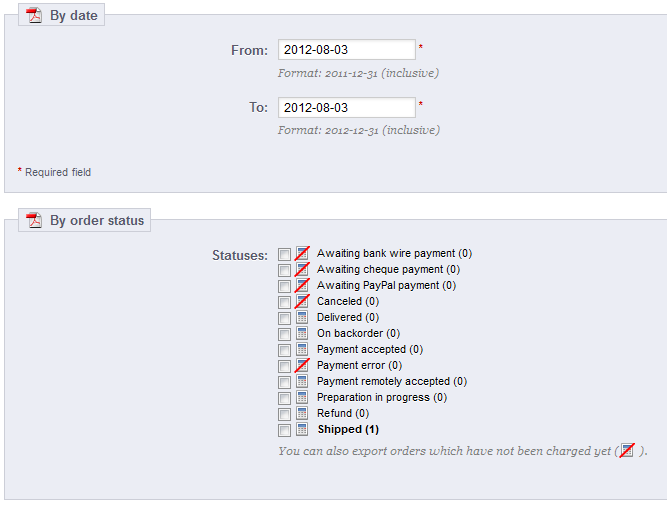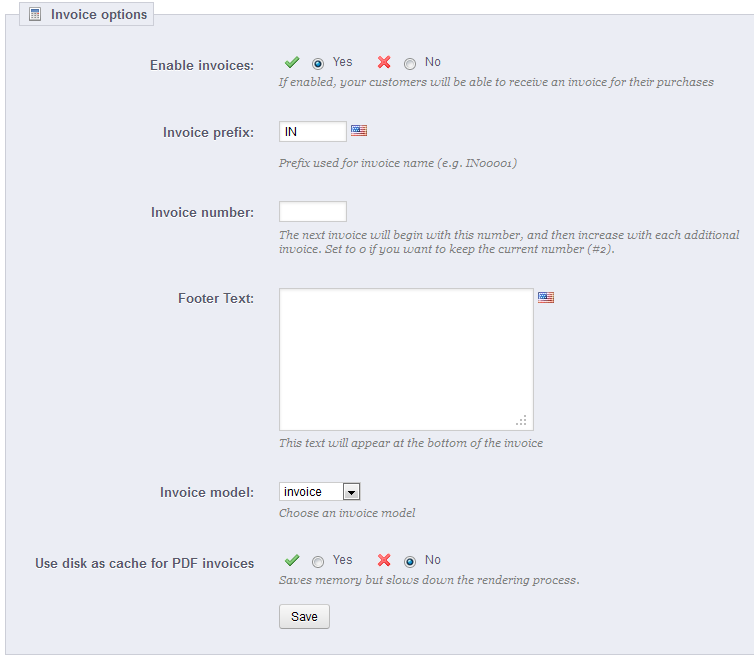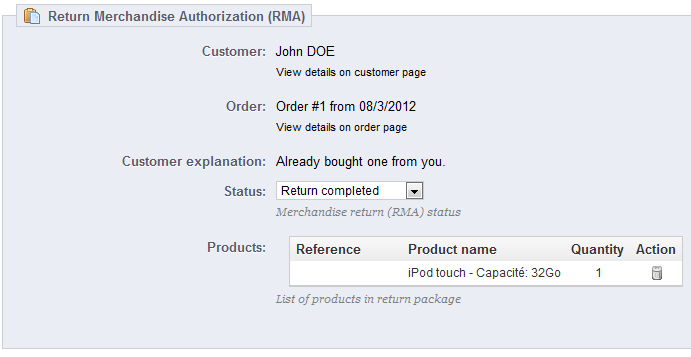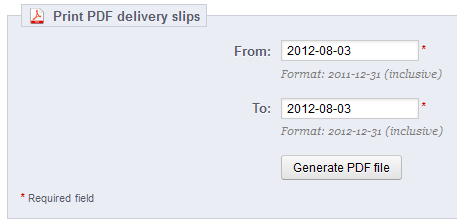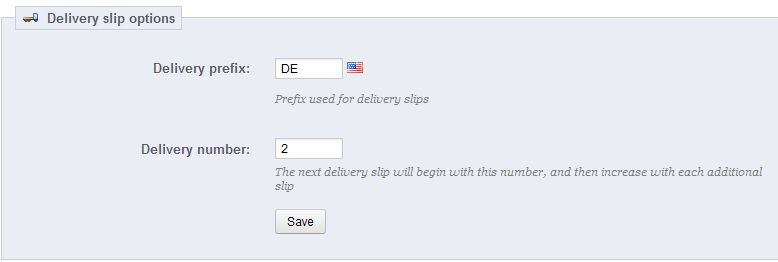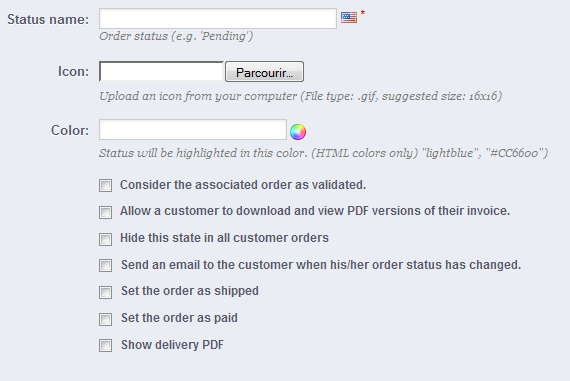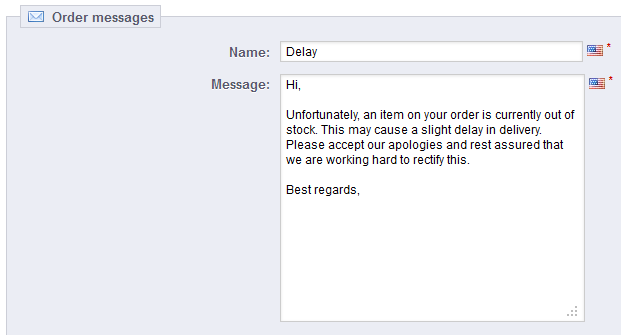...
The "Orders" page under the "Orders" tab menu enables you to see all of the information about all the purchases from your shop. All of your shop's transactions are available there, organized by date (by default, it is set to sort from newest to oldest).
You can filter the results and easily find the orders you're looking for by using the fields above. For instance, to identify Mr. Doe's orders, type Doe into the "Customer" field and then click "Filter".
...
Clicking "Add new" opens a new page with a single text field, labeled "Search customers". When creating a new order through the back-office, your first task is to associate that order with a customer. Type the first letters of the customer first name, last name or e-mail address, and PrestaShop will display the matching accounts.
| Info |
|---|
If the customer you are creating this order for does not even have a user account already, you can create one on the fly: click the "Add a new customer" button button to open a window with the main account details ready to fill. Once the account is saved, it becomes the chosen account for the order. Note that you will also have to register the customer's address – a "Add new address" button is available at the bottom of the page, in the "Addresses" section. |
Click the "Choose" button for the correct customer, and the whole order form appears. Its main section, "Cart", is where you will make all the necessary product decisions for this order.
The "Search a product" field enables you to dynamically find products to add: type the first letters of its name and PrestaShop will fill a drop-down selector with matching products. Choose a product, select a quantity, and click "Add to cart" button. You can of course choose among the many combinations of a product, if any.
Note that PrestaShop gives you an indication of the remaining stock for a given product, which enables you to tell the customer that you are out of stock for said product right from the order form.
The page also enables you to see the previous carts and orders from that customers, if any. If it turns out you are dealing with a cart that a customer somehow cannot validate, you can use that older cart for this order by clicking on the "Use this cart" action button (the "two windows" icon).
If needed, you can also grant that order a voucher/cart rule, and even create one on the fly by clicking on the "Add new voucher" button.
Finally, you need to specify to which address the order should be delivery (and possibly billed). Here, again, you can create new addresses on the fly using the "Add new addresses" button.
Viewing An Order's Details
...
The order detail sheet fills a full page.
This summary of the order gives you access to:
...
- Scroll down the page to the "Products" section.
- Add fields to the product sheet.
When adding a product, the products table gets a row added with a handful of fields. The first text field is actually a small search engine: type the first letters of a product to see a list of corresponding products. Select the one you want to add, and the grayed-out field of the row becomes available.
If the product has combinations, you can select it in a drop-down list that appears below the name: the unit price update accordingly.
Set the quantity of products, and then click the "Add product" button: the product is added
...
To cancel a product, go to the product list, and either delete the product by clicking on the "Delete" action (the "trashcan" icon), or by clicking on the "Edit" action if all you need is to remove some quantity of a product.
You can edit the quantity of many products at the same time.
If a product's quantity reaches 0, it is removed from the order altogether.
You cannot remove more than the quantity of product.
click the "red cross" icon to cancel your edit.
...
The first drop-down list in the order page enables you to change its status.
You can choose between the following statuses:
...
The action buttons in the top bar change depending on the order's status. For instance, once the order is in the "Delivered" state, the "Add a product" and "Remove products" turn into two new buttons: "Return products" and "Partial refund".
- Return products is to be used when the customer returns products: once the returned product has been received, you can mark it as returned directly in the order form. Click the "Return products" and a new column will appear, title "Return". Check the box the involved products, set the number of items that were return, and click the "Return products" at the bottom of the table.
Note that this will only work if you have enabled merchandise return for your shop! To enable merchandise return, go to the "Merchandise Returns" page under the "Orders" tabmenu, and in the "Merchandise return (RMA) options" section, choose "Yes" for the "Enable returns" option, and save. This will apply to all products and all orders.
Three options are available when set a product as returned, below the table: - Re-stock products. When checked, PrestaShop will consider that the returned product as available for sale again, and will therefore increase the stock for this product.
- Generate a credit slip. When checked, a credit slip will be created for the selected items. A credit slip is an acknowledgment from your shop that merchandise has been returned and that a refund has been issued. The customer can then use it as a discount for his or her next purchase.
- Generate a voucher. When checked, a voucher will be created for the amount of the selected items. A voucher takes the form of a discount code that the customer can enter during the checkout process. You can edit the customer's voucher by viewing the customer's page: from the current order's page, click on the link under the customer's name in the "Customer information" section; once in the customer's page, reach the "Vouchers" section. You can edit each voucher by clicking on the "Edit" icon.
Warning In PrestaShop 1.5, vouchers are part of a new kind of discount feature: "cart rules". They can be created and edited from the "Cart Rules" page, under the "Price rules" tabmenu. The cart rules creation process in the next chapter, "Creating Price rules".
...
You can get many PDF documents out of the order page. When available, they are listed in the "Documents" section of the page.
By default, you can download the order itself as a PDF, by clicking on the "Print order" button on right.
...
The shipping details of the current order can be partly edited. More specifically, you can change the tracking number: in the "Shipping" section, click on the "Edit" icon in the "Tracking number" column, and enter the new number.
Shipping Address
The "Shipping address" section enables you to edit the destination address of the package your team is about to send. You can either choose the drop-down menu to choose another of the addresses that the customers has already registered on your shop, or you can use the "Edit" icon to edit the currently chosen address.
If you need to send the package to an address that is not already registered in PrestaShop, you must first create it. To do this, go to the "Customers" tabmenu, open the "Addresses" page, and click in the "Add new" button. Do not forget to put the correct e-mail of the customer, as this is the way PrestaShop will know to associate that new address with your existing customer! Once done, go back to the order's page, and change the address using the drop-down menu.
...
If you need the payment to be tied to an address that is not already registered in PrestaShop, you must first create it. To do this, go to the "Customers" tabmenu, open the "Addresses" page, and click in the "Add new" button. Do not forget to put the correct e-mail of the customer, as this is the way PrestaShop will know to associate that new address with your existing customer! Once done, go back to the order's page, and change the address using the drop-down menu.
...
In the "Products" section, at the bottom of the products listing, you can find an empty table with an "Add new discount". This creates a simple discount, not as advanced as the vouchers/cart rules system but still useful.
Clicking it will open a new form, with the following items:
...
In the "New Message" section, at the bottom of the page, you can send a message to the customer, in order to give him or her information concerning the order, a delay, a surprise, or keep him informed on offers and specials. This is key to good business.
There are two links available:
- Click here to add a comment or send a message to the customer.
- You can send a message by writing it in the message box.
- Pre-written message can be saved and used multiple times, saving you the hassle of writing them over and over again. If you would like to send one of these messages, select it from the drop-down menu. You can add further details to the pre-written message if needed.
- Click here to see all messages. Rather than opening a message form, this link will take you to the "Customer service" page of the "Customers" tabmenu. This is fully explained in the "Managing Customers" chapter of this guide.
...
Each time an order from your shop is validated, an invoice is sent out to the customer. You can download the invoices for a single order from the order's page. The "Invoices" page under the "Orders" tab menu enables you to download a selection of invoices from past orders in PDF format, all at the same time (in the same PDF file).
You can print a PDF of several invoices depending on two main criteria:
...
You can choose whether or not invoices should available to your customers as soon as the order is made, as well as the Invoice Prefix and the invoice number you want listed on the printed version of the invoice. This feature can help you simplify the management of your account.
- Enable invoices. When disabled, your customer will not receive an invoice after their purchase. You will be responsible for handling the invoices, if your customers ask for one.
- Invoice prefix. You might like to have language-tagged invoices: "IN" in English, "FA" in French (for "facture"), "CU" in Spanish (for "cuenta"), etc. Or you could directly choose to have language codes: "EN", "FR", "SP", etc. Of course, you can also choose to not have a prefix at all.
PrestaShop will then generate the invoices number according to you settings: "#IN000001", "#FR000002", etc. - Invoice number. If your business has already had orders and invoices before you started using PrestaShop, you can use this option to start your invoice number from a higher number.
- Footer text. You can use to have a custom text at the bottom of all your invoices. The text will appear below the name of your shop in then invoice.
- Invoice model. Depending on your themes, you might be able to use more than one style of invoice. Test them with a fake order, in order to choose the one you prefer. If you know how to code in HTML, you can add your own invoice models or edit the existing ones: they are located in the
/pdf/folder of your PrestaShop installation. - Use disk as cache for PDF invoices. You can choose to store generated invoices on PrestaShop's server disk rather than in its server cache. While it saves on memory usage, it slows down the PDF generation itself, so use it knowingly.
...
Under the "Merchandise Returns" tabpage, you have the possibility of enabling customers to send products back to you. Simply make a choice, the time of validity, and save.
Once you have activated this option in your back-office, the customer can choose to return an item (provided the order is still in the time of validity). In order to do this, s/he must do the following:
- Access the "Orders History" section of his or her account.
- Select the order from which he wants to return an item.
- Select the product(s) that s/he wishes to return by checking the box next to its name(s).
- (optional) Add an explanation, in order for the shop team to understand why the customer wants to return this product.
Once the form is complete, the customer clicks on "Make an RMA slip", and the request is sent to you. the request appears in the customer's "Return Merchandise Authorization" page, acessible accessible from the account page.
A list of returns will appear in your back-office.
It is now up to you to accept it or deny it:
- Click on the name of the return to see more details.
- Change the status to continue with the return process or stop it.
Delivery Slips
A delivery slip is a notification of delivery. It can also be called "delivery note" or "advice note".
It is supposed to be put in the shipped package, along with the ordered products. It will have your shop's logo, and indicate the content. On receiving the package, the customer will be able to use the delivery slip in order to double-check the content of the package, see that nothing is missing from the order.
Printing a delivery slip is exactly like printing an invoice. Select the dates, as well as the options you would like, and then confirm them to create your documents.
You can print a PDF of several delivery slips depending only by date, which is very useful when you need to print all delivery slips for a given day or a given quarter. Select the start and end date, and click on the "Generate PDF file" button.
Delivery Slips Options
The two options are the same as for the invoice options:
...
The credit slip is now created and will be available in the Order Details well as in the "Credit Slips" tabpage.
You can click the link to download the PDF.
...
The various available statuses are visible and editable in the "Statuses" page, under the "Orders" menu.
The page displays a list of the currently registered order statuses, along with:
- Their distinctive colors: existing status have colors that help quickly decide if there's an issue with the order or if it all goes well.
- Their icons.
- Their ties to two PrestaShop behaviors (more are available):
- Should the customer receive e-mail when the order gets this status?
- Does this status allow the customer to download and view a PDF version of the order's invoice?
- The name of their e-mail template: you can edit these templates, language by language, in the "Translations" page under the "Localization" tabmenu. In the "Modify translations" section of the page, choose "E-mail template translations" in the drop-down menu, and then click on the flag of the language in which you wish to edit these templates.
- Their action icons: "edit" and "delete".
The return status list feature less information, because those statuses are merely labels with no impact on the order.
Creating a new order status
You can create a new status with the "Add New" button at the top. The creation form opens.
Fill out the form:
- Status name. Keep it very short and distinctive.
- Icon. You can use any 16*16 icon; for instance, the excellent and free FamFamFam Silk icon set: http://www.famfamfam.com/lab/icons/silk/
- Color. You should strive to have the status' color match the existing colors (if relevant). The default color usages are:
- Red/Orange: canceled or refunded orders,
- Crimson red: payment error,
- Blue: orders which are still awaiting payment,
- Light green: paid orders,
- Dark green: delivered orders,
- Purple: shipped orders,
- Pink: backordered orders.
- Options:
- Consider the associated order as validated. If enabled, this status marks all associated orders as "paid", and puts them in this same status.
- Allow customer to download and view PDF version of invoice. If disabled, you will have to send customers their invoice yourself.
- Hide this state in order for customer. This enables you to create internal statuses, for you and your team. Customers will never see this in their order status page.
- Send e-mail to customer when order status is changed. When enabled, a drop-down menu appears to let you choose which mail template to use.
- Set order as shipped. Be careful: once an order is set as "shipped", it cannot be set back.
- Set order as paid. Same here: once an order is set as "paid", it cannot be set back.
Creating a new
...
return status
You can create a new status with the "Add New" button at the bottom. The creation form opens.
It only features one field: set your desired status name, and save your creation.
...
To do this, go to the "Order Messages" page under the "Orders" menu. One default message is already saved: "Delay".
To add others, click on the "Add New" button. You can also edit the default message.
The form goes to the essentials:
...

